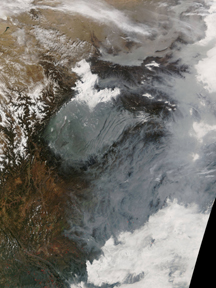
 China
has had fewer days with cloud cover over the past half-century, according to
new weather station data. At the same time, however, the region has cooled and
evaporation has decreased — suggesting instead the presence of more clouds,
which reflect solar rays and their heat. Researchers analyzing the new data
speculate that increases in pollution may be the culprit behind the paradox.
China
has had fewer days with cloud cover over the past half-century, according to
new weather station data. At the same time, however, the region has cooled and
evaporation has decreased — suggesting instead the presence of more clouds,
which reflect solar rays and their heat. Researchers analyzing the new data
speculate that increases in pollution may be the culprit behind the paradox.
A team led by Yun Qian of the Pacific Northwest National Laboratory in Richland,
Wash., looked at data taken from 1955 to 2000 from 537 weather stations scattered
across China. They determined that on average, differences between night and
day temperatures and the amount and duration of sunshine in China had decreased
around 2 percent every decade, which would suggest an increasing trend in cloud
cover. But, the team wrote in Geophysical Research Letters on Jan. 11,
human and satellite observations told a different story: Cloud cover decreased
slightly over that time period. Haze remained, however, measured by the stations
as overcast days.
China’s emissions of aerosol particles that create haze increased until
the mid-1990s, according to state records, and have seemed to level out since
then. Aerosol particles have properties that allow them to both scatter and
absorb solar radiation, depending on whether they are made of sulfate (which
reflects it) or soot (black carbon, which absorbs it). The “mismatch”
between cooling and increased smog, the team says, “reminds us of the complexity
of aerosol composition and mixing.”
In this case, the haze seems to have reflected more solar radiation, preventing
it from reaching the ground. Less heat on the ground would decrease the evaporation
of soil moisture, which contributes to cloud formation.
“The key in this case was the fact that the cloud fraction was decreasing
simultaneously with solar radiation,” which gives the new report a “unique
angle” on describing aerosols over China, says Mark Jacobson, an atmospheric
scientist at Stanford University in Palo Alto, Calif. Jacobson hazards his own
guess as to why aerosols might be further reducing solar radiation in the area:
As the particles absorb heat in the atmosphere, the warmer temperatures keep
water from depositing on clouds, as relative humidity increases. This lack of
water leads to smaller spread out clouds — in effect, blocking more solar
radiation.
Despite their speculation that smog is responsible, the researchers wrote that
people “cannot expect a simple correspondence between pollutant emissions
and solar radiation on annual or even decadal timescales.” Still, Qian
says that smoggy regions experienced a slight cooling effect, noting that the
particle pollutants possibly offset the background temperature signals from
global warming. “The emission issue is very difficult to predict,”
he says, depending on China’s future coal use and energy production, as
well as environmental protection policies and the adoption of sulfur emission
controls.
The research is “a very clever study showing the impact of increased aerosol
air pollution on climate in China — simple measurements showing profound
effects,” says Russell Dickerson of the University of Maryland in College
Park, with results consistent with satellite observations and past studies.
Dickerson says that particulate matter in the atmosphere “probably [has]
large-scale impacts” on chemistry and air quality. He sees the work as
support for a “call for action to implement methods for sustainable development
in Asian industry, transportation and agriculture.”
Naomi Lubick
Back to top
 |
Geotimes Home | AGI Home | Information Services | Geoscience Education | Public Policy | Programs | Publications | Careers |